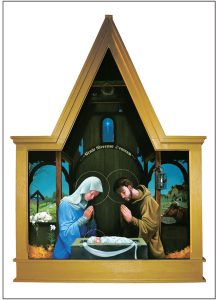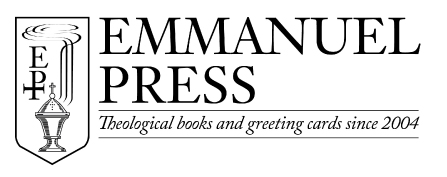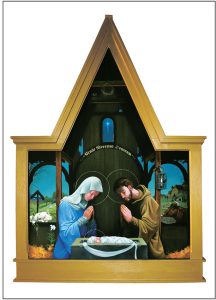THE LATEST NEWS
New Download: Solid Declaration Readings According to the Church Year
Just in time for the beginning of the church year on Advent 1, we are pleased to offer a new free download of Solid Declaration readings for major feasts and Sundays of the one-year series. Reading the Lutheran Confessions is important to both pastor and parishioner. When done weekly, it is a helpful and salutary discipline. Pr. Craig Meissner of Immanuel Lutheran Church, U.A.C., Steger, Illinois, has provided the following reading schedule, linking sections of the Solid Declaration to the church year themes in the historic one-year series.
*Find it in our Downloads tab or click here to go directly to the pdf
_________________________
Pr. Meissner writes:
The Solid Declaration is a document of utmost importance for confessional Lutherans. Like other books contained in the Book of Concord, it teaches key distinctions and doctrines essential for understanding and abiding in the true faith in the face of errors that American Lutherans still confront today. The Solid Declaration usually does this with less-detailed discussions of people, places, histories, etc., of those involved in the various controversies compared to other confessional documents, except the creeds and catechisms. Parishioners may therefore find these selections less cumbersome, though still very much edifying, making it appropriate for printing in a church bulletin or newsletter and perhaps inspiring further study of the Lutheran Confessions.
The vast majority of the Solid Declaration is covered in this reading schedule. My goal was to apply nearly all of the Solid Declaration to each of the church year Sundays and most major festivals commonly observed in our congregations. Keeping in mind the limited space of church bulletins and newsletters, I omitted only those paragraphs where a controversy or heretical position was introduced without a sufficient conclusion or rebuttal as well as those that contained extraneous personal or local details.
Some days of the church year have multiple options from the Solid Declaration provided; others have just one. You will note that the selections tend to be shorter during the “school year” and longer in the Trinity season, when there would likely be more space in a church bulletin. The pastor may alter these as he deems fit. One more suggestion before beginning this exercise: the pastor may wish to first present “The Comprehensive Summary, Foundation, Rule, and Norm” as an introduction to the readings.
May this chart be a useful and edifying tool for you and those you serve in the Lord’s Name.
Pr. Craig Meissner, S.T.M.
Immanuel Lutheran Church, U.A.C., Steger, Illinois
New Christmas Cards with Art by Edward Riojas are Now Available!
Since the debut of our first Christmas cards almost one year ago, we have been pleased and humbled by the fantastic response to cards which combine beautiful, unique works of art with a clear confession of our Savior’s birth.
This year we are thrilled to offer two new Christmas cards with artwork by Edward Riojas, an artist whose work is also included in The Brotherhood Prayer Book and on several of our greeting cards and book covers. His sacred work can also be found in private collections and sanctuaries throughout the U.S. and Canada and in numerous Lutheran publications.
The first card, Adoremus, features a seven foot tall oil painting on wood originally created as an entry for ArtPrize 2012. There is much symbolism in the details: the lily, which is a symbol of the Virgin Mary; the carpenter’s tool next to the lantern with a single burning light, representing Christ as the Light of the world; the eight-pointed Bethlehem star which announces Christ’s birth but also alludes to His death by its cross shape; the crown of thorns that literally hangs over Jesus’ head; and the inn with smoke intentionally excluded from the chimney, showing a lack of hospitality. The inside text reflects the Latin included in the piece (Venite Adoremus Dominum): Word of the Father Now in flesh appearing. O come, let us adore Him.
The second card, Virgin and Child, features an oil painting on wood in the artist’s personal collection. Riojas used his daughter as a model for the Virgin Mary, depicting the solemn and holy night of our Lord’s birth. The inside text proclaims Isaiah’s words of prophesy: For to us a child is born, to us a Son is given…and his name shall be called Wonderful Counselor, Mighty God, Everlasting Father, Prince of Peace.
Like our other Christmas cards, these cards are 5″ x 7″ with classic gold foil-lined envelopes. Also be sure to take a look at our other ecclesiastical greeting cards, including gorgeous fresco and stained glass cards as well as Baptism, Easter, and other Christmas cards.
Art as Confession: Student from Saudi Arabia learns about Christ through Riojas’ Adoremus
 “‘Adoremus’ is hanging in the barn. After spending seemingly endless hours painting it, hauling it to ArtPrize, babysitting it for the duration, hauling it back home and not selling it, one would think the labor of my hands was not blessed.
“‘Adoremus’ is hanging in the barn. After spending seemingly endless hours painting it, hauling it to ArtPrize, babysitting it for the duration, hauling it back home and not selling it, one would think the labor of my hands was not blessed.
But there was that one college student assigned to ask questions of the ArtPrize artists. He chose to ask me questions, because I was standing there by my piece. I began explaining the symbolism and its deeper meaning, and ended by explaining the very basics, which we too often take for granted.
I will never know what happened to that young man. I do know he could be killed for asking the questions which weren’t part of his assignment; for asking why the man in my painting had to die; for asking how they killed this man. That student was an exchange student from Saudi Arabia, and he had never heard of Jesus Christ.
Being reminded that the work of my hands is a blessing sometimes comes in very profound ways. I pray that it will continue to be so blessed.”
-excerpted from Ed Riojas’ Facebook page, originally posted October 28, 2012
Seed-Grains of Prayer: Sunday Evening Prayer
“I render thanks unto Thee, O true and everlasting Light, that Thou hast this day protected me by Thy light and Spirit against every grievous sin. And now, during the night which Thou hast ordained for the rest of my poor body, O Lord, grant unto my weary soul to find rest and peace in Thee against all the wiles and onslaughts of the evil one. Cause my mind and my thoughts, together with my hands and my feet, to glorify Thee and be silent before Thee, Who art present and mindful of Thine own, when deep slumbers embrace them. O, let not this wicked flesh overmaster my poor soul, lest I forget Thee in the night watches. Into Thy hands I commit my spirit, O gentle Shepherd, into Thy faithful hands. Thou hast redeemed my soul, O Lord God, most faithful; permit me not to fall away from Thee. Watch by me and cover me with the protection of Thy wings. When the night is past, awaken me and grant me the light by which I may walk and dwell safely with Thee in yonder eternity. Hear my prayer and answer me, O Thou Who slumberest not nor sleepest; through Jesus Christ. Amen.”
Wilhelm Loehe, Seed-Grains of Prayer, #103.
Pr. David Petersen on Matthew 25:31-46
“When did you ever do anything? Change the question. Do not be afraid. Look up and ask, ‘When did Christ do something?’ That is the question that leads to life. Don’t look to your works. Look to His. The Christ went to trial and was condemned by Pilate. The ironic title ‘King of the Jews’ was placed over His head, ironic because it was a false charge, but completely true. There He paid for sins that He did not commit, and which we don’t even remember, and now even He has forgotten them. He has been condemned and has died that you might get credit for works you did not perform. Turn from ‘When did we fail?’ to ‘When, O Lord, did you serve us?’ And then, ‘Where, O Lord, do you serve us?’ For He lives. And He serves in His Word and Holy Supper.”
______________
Pr. David H. Petersen — an excerpt from his sermon on Monday of Invocabit (Matt. 25:31-46), included in his upcoming sermon book

Let’s stay in touch! To receive the most current information on our products and new releases, join our email list today!



